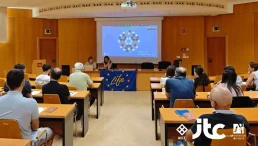Sustainable ceramic inkjet inks obtained through the LIFE REPLAY project
Castellón, 22/09/2025
• 5,000 m2 of eco-friendly ceramic tiles incorporating separated waste have been produced industrially.
• More than 4 tonnes of eco-friendly ceramic inkjet inks have been produced industrially, also incorporating the treated waste.
The Institute of Ceramic Technology (ITC) hosted the closing event of the LIFE REPLAY project: “A new life for ceramic inkjet waste.”
The initiative, supported by the European Union’s LIFE Programme (Ref.: LIFE 20 ENV/ES/000115), has demonstrated how ceramic inkjet waste can be successfully reintroduced into industrial processes, contributing to a more sustainable and circular ceramic industry.
At the opening ceremony, ITC’s Secretary of the Governing Council and Technical Director, Irina Celades, welcomed participants. This was followed by a presentation from Dr. Francisca Quereda, head of ITC’s Materials Department, who detailed the project’s results: a prototype separation system designed to recover and reuse components of ceramic inkjet waste while ensuring industrial quality standards.
As Francisca Quereda explained, the project has focused on ensuring that ceramic inkjet waste can be reintroduced into the ceramic industrial process through a specific separation procedure that meets industrial requirements. Its main objectives are to promote sustainability and minimise waste disposal costs.
The process separates two main components:
• Solid compounds containing heavy metals, which can be reintegrated into the manufacture of ceramic tiles and new inks.
• Organic solvents, which are recovered for reuse.
This approach has been validated on an industrial scale, leading to the production of over 5,000 m² of eco ceramic tiles and more than 4 tonnes of eco inks with a high recycled content. These results prove that inkjet waste can become a valuable raw material, reducing the dependence on virgin resources, and cutting waste disposal costs.
During the event, representatives from consortium partners TECHLAM and AKCOAT shared the lessons learned in developing the reuse methodology, while ITC and CTR addressed the legal implications related to achieving end-of-waste status.

The LIFE REPLAY project has been developed under the coordination of the Institute of Ceramic Technology with the participation of the companies Akcoat Recubrimientos Quimicos Especializados S.L.U (AKCOAT); Centro de Tratamiento de Residuos del Mediterráneo Sl (CTR); NEPTURY TECHNOLOGIES, S.L. (NEPTURY); LEVANTINA TECHLAM S.L. (TECHLAM) and KEROS CERÁMICA, S.L. (KEROS).


